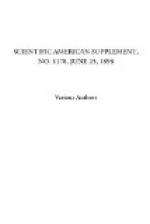Patents were granted in 1858 to Hiram L. Hall, for the treatment of waste rubber by boiling in water; also, by subjecting it to steam; and again, by combining various resinous and other substances with it. The two inventors named assigned their patents to the Beverly Rubber Company, of Beverly, Mass., controlled then by the proprietors of the New York Belting and Packing Company, and their processes became the basis of an important business in rubber clothing.
The low cost of the devulcanized rubber, as compared with new rubber, alone gave them a great advantage over other manufacturers, in addition to which they escaped the payment of a license to work under the Goodyear patents.
Many army blankets, made for the government during the civil war, were waterproofed with Hall’s devulcanized rubber, and from that period little new rubber has been used in the manufacture of heavy rubber coats. The other patents in this class do not deserve special mention.
It having been established that rubber is rubber, no matter where found, manufacturers gradually turned their attention beyond the scraps and cuttings which remained after making up their goods. There was beginning to be a good demand for ground-up rubber car springs, wringer rolls, tubing and other rubber goods free from fiber, after it had been so treated as to remove the sulphur contents and restore the gum to a workable condition. But this left out of account rubber footwear, belting, and hose, not to mention the later heavy production of bicycle tires. There were only a few uses to which rubber waste containing fibrous material could be put when ground up and devulcanized without the removal of the fiber. It could be put into a cheap grade of steam packing or mixed in a powdered form with new rubber for the heels of rubber boots and shoes. There was an early patent for a process for “combining fibrous materials with waste vulcanized rubber, rendered soft and plastic.” But all the other patents which come within the scope of this article had for their object the separation of fibers from the rubber.
An important advance was marked by the Hayward patent (No. 40,407), granted in 1868, for “boiling waste rags of fibrous material and rubber in an acid or alkali, for the purpose of destroying the tenacity of the fibers of the rags, so that the rubber may be reground.” But this process extended only to the weakening of the fibers, and not their complete destruction. A later patent, in the same year, provided for exposing the ground rubber waste to the direct action of flames of gas or inflammable liquids, by which the foreign matters would be consumed and the rubber rendered plastic and cohesive, but it is not on record that this process received any particular application.




